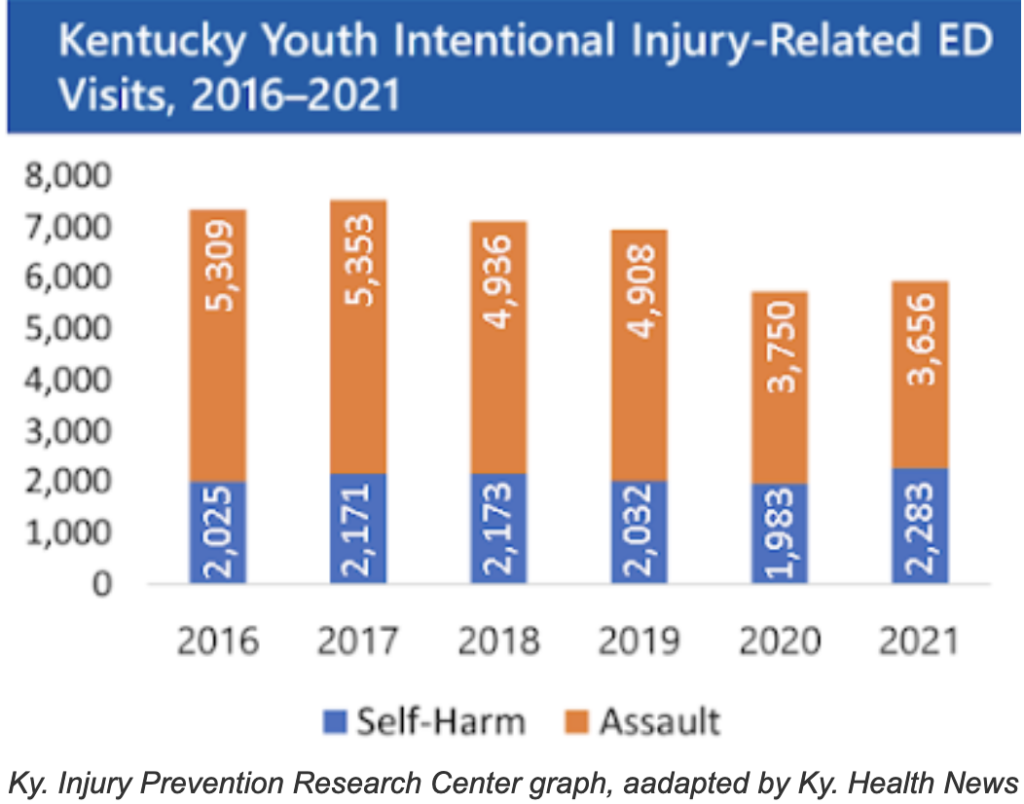More Kentucky youth received emergency care for self-harm in 2021 than in 2020, reversing decline in youths’ intentional injuries

That’s according to a report from the Kentucky Injury Prevention and Research Center on intentional injury-related emergency department visits among Kentuckians aged 10 to 24. It says people in this age group, which it calls youth, have an increased risk for these injuries that often require medical care.
Intentional injuries are violence-related injuries, whether they be directed toward oneself, called self-harm or intentional injury in this report; or directed toward others, which this report refers to as assault.
The researchers found that from 2016 to 2021, Kentucky resident youth made 40,579 emergency-department visits for intentional injuries, amounting to about 6,763 visits per year. It notes that the median cost of an ED visit for self-harm injuries was $2,577 and for assault injuries was $1,644.
In those years, most of the intentional injury-related ED visits occurred in people aged 15 to 24, followed by those 10 to 14, the report says. And when it comes to self-harm, an overwhelming number of those ED visits, or 71%, involved girls or women.
Slightly more male youths, 52%, visited EDs as a result of assault. Most self-harm injuries (58%) and assault injuries (63%) were among youth living in metropolitan areas.
The report also breaks down injury-related ED visits by the nature of the injury. The top two self-harm injuries in 2016-21 were drug poisoning, 50.3%, and cut or pierce, 31.5%. The top two assault injuries were striking by or against, 68%, and child or adult abuse, 10.7%. Only 2.1% of the ED visits for assault injuries were related to firearms.
Among self-harm injuries, the most common types were poisoning (52%), open wounds (22%), and superficial injuries or contusions (11%). The most common types of assault injuries were superficial or contusion (30%), open wound (18%), other effects of external causes (15%), and fractures (13%)
The report also found that most Kentucky youth ED visits for injuries related to intentional harm were discharged to home or to self-care: 48.4% of those admitted for self-harm and 93.8% of those admitted for assault. It said 13.5% of the self-harm patients were discharged to an inpatient facility and 34.2% were discharged to a health-care facility.
The ED visit rate for youth self-harm injuries varied by region in Kentucky from 181 per 100,000 people in the Buffalo Trace Area Development District to 333.7 per 100,000 in the Kentucky River ADD. The Green River ADD had the second highest rate, at 305 per 100,000.
The ED visit rate for youth assault injuries ranged from 385.4 per 100,000 in the Barren River ADD to 718.3 in the Kentucky River ADD. Two other ADDs were among the highest rates for this measure, KIPDA, at 705.2 per 100,000 and Green River, at 565.6 per 100,000.